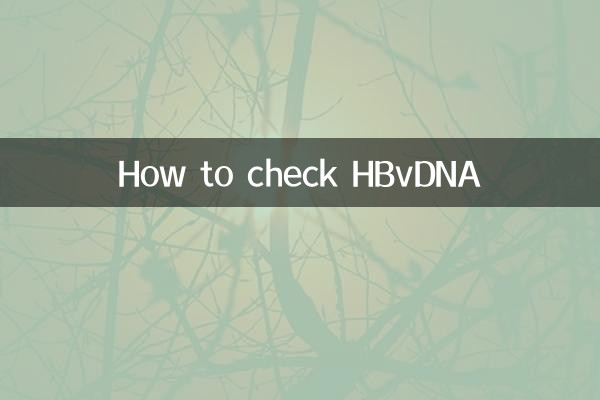How to check HBV DNA
Hepatitis B virus (HBV) infection is an important public health issue worldwide. HBV DNA testing is one of the key means of diagnosing and monitoring hepatitis B virus infection. This article will introduce in detail the examination methods, clinical significance and related precautions of HBV DNA.
1. The clinical significance of HBV DNA detection

HBV DNA detection is mainly used in the following aspects:
| Application scenarios | significance |
|---|---|
| diagnosis | Confirm active HBV infection to distinguish acute or chronic infections |
| Treatment monitoring | Evaluate the effectiveness of antiviral treatment and guide the adjustment of treatment plans |
| Prognosis assessment | Predict the risk of disease progression, such as cirrhosis, liver cancer, etc. |
| Infectiousness Assessment | Determine the patient's infectiousness |
2. HBV DNA detection method
Currently, there are the following methods of HBV DNA testing in clinical practice:
| Detection method | principle | Features | Sensitivity |
|---|---|---|---|
| Real-time fluorescence quantitative PCR | Based on DNA amplification and fluorescence signal detection | High specificity, quantitative accuracy | 10-20 IU/mL |
| Digital PCR | Split the sample into thousands of microreaction units | Absolute quantification, not affected by amplification efficiency | 1-5 IU/mL |
| Isothermal amplification technology | Amplification of nucleic acid at constant temperature | Simple equipment, suitable for the base layer | 50-100 IU/mL |
| Hybrid capture method | Nucleic acid hybridization and signal amplification | Easy to operate | 1000 IU/mL |
3. HBV DNA detection process
1.Sample collection:Usually 3-5ml of venous blood is used and collected using EDTA anticoagulation tube.
2.Sample processing:Store at 2-8℃ for no more than 24 hours. If long-term storage is required, place it at -70℃.
3.DNA extraction:Viral DNA is extracted using a commercial nucleic acid extraction kit.
4.Amplification detection:The extracted DNA was subjected to PCR or other amplification reactions.
5.Results analysis:Calculate the HBV DNA concentration according to the standard curve.
4. Interpretation of test results
| Test results (IU/mL) | Clinical significance |
|---|---|
| <20 | HBV DNA was not detected, suggesting that the virus replication is inactive |
| 20-2000 | Low-level replication, and evaluation needs to be combined with other indicators |
| 2000-20000 | Medium level replication, suggesting active infection |
| >20000 | High level of replication, strong infectiousness, high risk of disease progression |
5. Precautions for testing
1.Detection timing:It is recommended to collect blood on an empty stomach in the morning to avoid dietary influence.
2.Drug effects:Antiviral drugs will reduce HBV DNA levels and should be tested before taking the medication or after the appropriate time of discontinuation.
3.Quality Control:Select a certified laboratory for testing to ensure reliable results.
4.Dynamic monitoring:Patients with chronic hepatitis B should undergo regular review of HBV DNA levels (3-6 months).
6. Latest research progress
Recent studies have shown that ultra-high sensitivity HBV DNA detection (lower detection limit <1 IU/mL) can detect virological breakthroughs earlier and help optimize treatment plans. In addition, new detection technologies such as third-generation sequencing show good prospects in HBV drug-resistant mutation detection.
7. Summary
HBV DNA testing is an important tool for hepatitis B management, and accurate detection and correct interpretation of results are crucial for clinical decision-making. With the advancement of detection technology, HBV DNA testing will play a greater clinical value and provide more powerful support for the accurate diagnosis and treatment of hepatitis B patients.

check the details

check the details